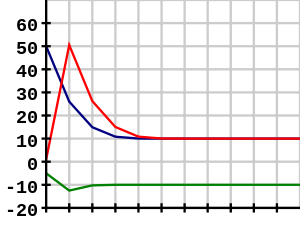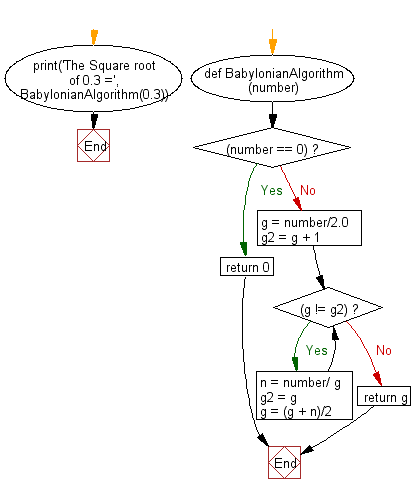Python Math: Computing square roots using the Babylonian method
Python Math: Exercise-18 with Solution
Write a Python program to computing square roots using the Babylonian method.
Perhaps the first algorithm used for approximating √S is known as the Babylonian method, named after the Babylonians, or "Hero's method", named after the first-century Greek mathematician Hero of Alexandria who gave the first explicit description of the method. It can be derived from (but predates by 16 centuries) Newton's method. The basic idea is that if x is an overestimate to the square root of a non-negative real number S then S / x will be an underestimate and so the average of these two numbers may reasonably be expected to provide a better approximation.
Graph Presentation

Graph charting the use of the Babylonian method for approximating the square root of 100 (10) using starting values x0 = 50, x0 = 1, and x0 = −5. Note that using a negative starting value yields the negative root.
Graph Credits: Crotalus Horridus
Sample Solution:-
Python Code:
def BabylonianAlgorithm(number):
if(number == 0):
return 0;
g = number/2.0;
g2 = g + 1;
while(g != g2):
n = number/ g;
g2 = g;
g = (g + n)/2;
return g;
print('The Square root of 0.3 =', BabylonianAlgorithm(0.3));
Sample Output:
The Square root of 0.3 = 0.5477225575051661
Flowchart:

Visualize Python code execution:
The following tool visualize what the computer is doing step-by-step as it executes the said program:
Python Code Editor:
Have another way to solve this solution? Contribute your code (and comments) through Disqus.
Previous: Write a Python program to print the first n Lucky Numbers.
Next: Write a Python program to multiply two integers without using the * operator in python.
What is the difficulty level of this exercise?
Test your Programming skills with w3resource's quiz.
Python: Tips of the Day
Find current directory and file's directory:
To get the full path to the directory a Python file is contained in, write this in that file:
import os dir_path = os.path.dirname(os.path.realpath(__file__))
(Note that the incantation above won't work if you've already used os.chdir() to change your current working directory, since the value of the __file__ constant is relative to the current working directory and is not changed by an os.chdir() call.)
To get the current working directory use
import os cwd = os.getcwd()
Documentation references for the modules, constants and functions used above:
- The os and os.path modules.
- The __file__ constant
- os.path.realpath(path) (returns "the canonical path of the specified filename, eliminating any symbolic links encountered in the path")
- os.path.dirname(path) (returns "the directory name of pathname path")
- os.getcwd() (returns "a string representing the current working directory")
- os.chdir(path) ("change the current working directory to path")
Ref: https://bit.ly/3fy0R6m
- New Content published on w3resource:
- HTML-CSS Practical: Exercises, Practice, Solution
- Java Regular Expression: Exercises, Practice, Solution
- Scala Programming Exercises, Practice, Solution
- Python Itertools exercises
- Python Numpy exercises
- Python GeoPy Package exercises
- Python Pandas exercises
- Python nltk exercises
- Python BeautifulSoup exercises
- Form Template
- Composer - PHP Package Manager
- PHPUnit - PHP Testing
- Laravel - PHP Framework
- Angular - JavaScript Framework
- Vue - JavaScript Framework
- Jest - JavaScript Testing Framework
